Labour MP JON CRUDDAS recently delivered the inaugural George Lansbury Memorial Lecture at Queen Mary University in Mile End, east London. He called it ‘The Choice before One Nation Labour – to Transact or Transform’. Here is the text.
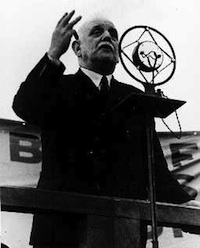 George Lansbury is one of the great figures in the history of the Labour Party, a man adored and dismissed in equal measure. He had “no brain to speak of”, according to Beatrice Webb. He was “the most lovable figure in British politics”, suggested AJP Taylor.
George Lansbury is one of the great figures in the history of the Labour Party, a man adored and dismissed in equal measure. He had “no brain to speak of”, according to Beatrice Webb. He was “the most lovable figure in British politics”, suggested AJP Taylor.
Just this week on Radio 4 Shirley Williams was recounting a childhood where family friends such as Herbert Morrison treated Lansbury with disdain. Yet here, in the East End, ‘good old George’ was greeted with popular acclaim – his name was literally chanted by children when he appeared in schools or playgrounds.
Lansbury is being rediscovered, although his rehabilitation is far from complete.
However, when we talk about the rediscovery of Lansbury we are really talking about something bigger. Orthodox social democratic politics has crashed across Europe. Millions of voters have been lost. We have to find a new politics to reconnect with people, and the way we do that is to reclaim the parts of our history which will help.
Through Lansbury we can rediscover exiled traditions within Labour: by returning to questions of ethics and virtue; to lost utopias; by rebuilding hope, energy and vitality through returning to issues of principle and character.
It is about re-imagining what a Labour Party could be. This re-imagined socialism is romantic, not scientific; humane and warm; passionate yet humble; it is about rediscovering a political sentiment. It pushes back against party orthodoxy, careerism and transactional politics.
That is why I applaud the work of the Lansbury Memorial Committee. Your efforts to promote his life and work help us re-imagine what Labour could be today.
A brief history
George Lansbury was an east London MP for Bow and Bromley from 1910 to 1912 and from 1922 to 1940. He was leader of the Labour Party from 1932 to 1935.
He lived at 39 Bow Road. The site is now occupied by a block of flats that bears Lansbury’s name and carries a memorial plaque. At the corner of Bow Road and Harley Grove, there is a stone memorial that describes him as “a great servant of the people”.
He was honoured by the people. The Lansbury Estate, Lansbury Gardens, many street names both in London – including in my Dagenham constituency – and in his Suffolk birthplace, as well as the Lansbury Lido on the Serpentine, are all named after him.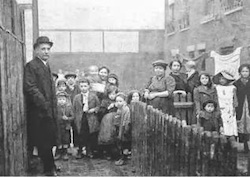
He was born on 21 February 1859. His father was a migrant worker. His mother, Anne Lansbury, was of Welsh heritage. His parents’ drinking defined George’s lifelong abstinence from alcohol. His family were nonconformist and radical. In 1868 they moved to Bethnal Green.
His initial political involvement was with the Liberal Party, then, in 1892, he helped form the Bow and Bromley branch of the SDF. He later joined the ILP. On its formation in 1906 Lansbury joined the Church Socialist League and became its vice-president.
In 1912, two years after becoming an MP, he clashed with Herbert Asquith over the issue of women’s suffrage and resigned his seat. “It was not a wise political decision,” he later said. He lost by 751 votes.
Campaigning for women’s suffrage, Lansbury was charged with sedition in 1913 and jailed in Pentonville Prison.
In 1912 he helped found the Daily Herald. In 1922, desperately short of funds, Lansbury reluctantly handed over the paper to the TUC and the Labour Party. Between 1925 and 1927 he edited Lansbury’s Labour Weekly.
He established the first pioneering training school for destitute Poplar children in 1905, called Hutton Poplars in the Essex countryside, the model for many subsequent children’s homes.
As Labour Mayor of Poplar, Lansbury led the Poplar Rates Rebellion in 1921, opposing not only the government and the London County Council, but also leaders of his own party. It was not the only time he and Herbert Morrison were on opposite sides.
The rebels refused to hand the tax precept to the LCC; instead they gave it to the poor. Thirty councillors, including six women, were jailed by the High Court for six weeks. Council meetings were held in Brixton Prison.
A rates revision was won and Lansbury returned to parliament in 1922. In 1927 he was elected chairman of the Parliamentary Labour Party. In the second Labour government of 1929 he was First Commissioner of Works.
Fifty-one Labour and ILP MPs survived the 1931 election, including Lansbury. In 1932, Arthur Henderson stood down from the leadership of the party in the country and Lansbury was elected leader.
Through the early 1930s his absolute pacifism brought him into conflict with the party leading to his resignation in 1935 after a brutal collision with Ernest Bevin at the Brighton conference. Giant hailstones smashed into the roof of the conference centre and the delegates sang in praise of him.
He was subsequently chair of the No More War Movement and the War Resisters’ International, and president of the Peace Pledge Union.
He died of cancer on 7 May 1940, aged 81, in Manor House Hospital in north London.
He married Bessie in 1880. They had 12 children: he was the father-in-law of suffragette Minnie Lansbury, the Belfast-born actress Moyna MacGill, and historian and novelist Raymond Postgate.
Lansbury was also grandfather of actress Angela Lansbury, the producers Bruce and Edgar Lansbury, and the animator and puppeteer Oliver Postgate.
This potted history suggests Lansbury is not easy to categorise. In the 1880s and early 1890s he was involved in all four of the forces critical to the development of a distinct Labour tradition: industrially, in the New Unionism of the period; organisationally, in the SDF, the ILP and with the Fabian Society.
He stood with Ben Tillett at the 1889 dock strike and, at times, was active with the Fabians. In 1892 he joined the SDF, becoming its national organiser in 1895, and subsequently ran for parliament three times under its banner. In 1903, he joined the ILP and emerged as one of its sponsored stars within the PLP.
How do we make sense of it?
Attlee, Lansbury and the ILP
The east end of London is fundamental to the history of Labour. Two key figures, though not from here originally, had their characters forged in these streets and the local ILP of the first decade of the last century.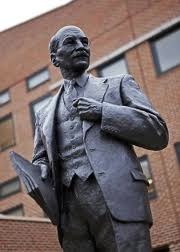
Most prominent is Clement Attlee of Haileybury House and Toynbee Hall (left), the youngest ever mayor of Stepney, a local MP, leader of the Labour Party, and then of the country. Attlee was arguably the greatest prime minister this country has ever had.
Then there is the greatest Labour Leader of the Opposition: George Lansbury.
To have had a third Labour government in 1945, or the governments of Harold Wilson and Jim Callaghan in the 1960s and ’70s, or the Blair and Brown governments of more recent years, you had to have a party for them to inherit and lead. This is what Lansbury delivered through his personal character.
According to Raymond Postgate, the PLP Lansbury led in 1932 “was reeling from the double shock of treachery and defeat. It wanted someone who could restore its confidence in human decency.” Desertion had destroyed the PLP. In Lansbury they “found someone whom they loved and who loved them with no touch of patronage”.
This is part of his legacy. To quote George Thomas: “He not only saved the soul of the party, he saved the party. We could have sunk into oblivion and the Liberals could have been reborn.”
It is the ILP association with Attlee and Lansbury that is vital. This year marks the 120th anniversary of the ILP. Lansbury’s biographer John Shepherd described the ILP as Lansbury’s “natural home”. Attlee described the critical importance of his own journey to the ILP. It anchors them both within a distinctive English socialist tradition and bridges their political lives.
In 1919, Major Attlee became the youngest ever Mayor of Stepney. He supported Lansbury and the Poplar Rates Rebellion in 1921. He was elected MP for Limehouse in 1922 at the same election that saw Lansbury get back into parliament a decade after resignation.
In 1934, Attlee became acting leader for nine months when Lansbury fell and nearly died. Later Attlee defeated Greenwood and Morrison to take over from Lansbury.
The young Attlee joined with 15 others to form the Stepney branch of the ILP in January 1908; five years earlier, a few streets away, Lansbury had taken a similar journey.
Founded in Bradford in 1893, the ILP grew from the bottom up, “from those shadowy parts known as the provinces”, to quote EP Thompson. Its image was one of bohemianism: “braving apathy and hostility, buoyed up by optimism, concerned not with the minutiae of political dealings but the broad uncomplicated advocacy of ethical principles”.
Under Hardie in 1895 the ILP turned away from the doctrinaire economism of the SDF. Instead it created a unique blend of domestic socialism. In the notion of a Labour church and the Socialist Sunday School movements with their alternative commandments which sought “the realisation of heaven in this life by the establishment of a society founded on justice and love to thy neighbour”, and to “honour the good, be courteous to all, bow down to none”.
Its politics were ethical, not materialistic, romantic and utopian, built around the dignity of the human being and our fundamental equality.
For Attlee it was a secularised ethic; for Lansbury a Christian one. Both refracted into a story of patriotic renewal and English virtue, although they divided around military intervention – one was the second-to-last off the beach at Gallipoli, the other resigned from the party leadership because of his pacifist absolutism.
The ILP’s radicalism, forged in these streets, defined the political certainties and leadership qualities of Lansbury and Attlee. It held the party together after 1932, yet propelled Lansbury into resignation. It defined the texture of the 1945 government. It enthused Attlee’s political passions, albeit locked down within a English middle class “rib cage of tradition” and disguised by what Frank Field has called the self-creation of a personal political “death mask”.
It is part of a now exiled English socialism – let’s give it a name. Let’s call it a One Nation politics.
A distinct English socialism
The final political speech made by William Morris was in Holborn Town Hall in 1896. He was seconding a George Lansbury motion. Much later, on the 25th anniversary of Morris’s death, Lansbury sat in a prison cell reflecting that “fellowship is life” and on “his conception of what life would be when men and women are free”. The key to Lansbury is that he offers us the link between the Labour Party and Morris.
After the Second World War, parts of the so-called New Left in the UK sought to focus on Morris and his work as part of a general rehabilitation of a perceived English historical socialist arc. This owed a profound debt to English romanticism, anti-scientific and artistic in orientation.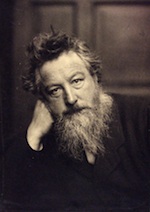
EP Thompson’s work is part of a distinct political project within the Communist Party to identify a specific English radicalism – a politics of virtue – in the character of Morris himself (left), but also in that of the emerging working class. The sub-title of Thompson’s biography of Morris is Romantic to Revolutionary.
Raymond Williams, in his classic text Culture and Society, defines a political, artistic and cultural tradition from John Ruskin, through Morris, to the modern New Left. Starting with Ruskin, he focuses on his resistance to laissez faire society through artistic criticism, where “the art of any country is the exponent of its social and political virtues… the exponent of its ethical life”.
What we value in life is taken out of the realm of political economy – of supply and demand, and calculus – and instead relates to the virtue of labour itself, seen as the “joyful and right exertion of perfect life in man”.
Within Ruskin, the notion of wealth and value, and indeed labour, are used to attack 19th century liberalism for its cold utilitarianism, and instead promote a society governed by “what is good for men, raising them and making them happy”. To live a virtuous life, to become wiser, compassionate, righteous, creative. What it is to become a ‘freeborn Englishman’?
What is of value is not ‘exchange value’. This amounts to a radical critique of political economy, of economic transactions. It is the source of a distinctly English, radical transformative politics, one that is sometimes identifiable within the Labour Party.
Morris is the critical link, as this form of socialist thought is attached to the political formation of the emerging working class in the late 19th century. This turbulent period of class struggle occurs alongside a ‘neo-classical’ economic revolution which removed value away from labour itself into the scientific realm of individual rational preferences. It still dominates today. It is called neo-liberalism.
The socialism of Morris is grounded in the emancipatory conception of human labour and creativity. Art constitutes a politics of resistance to life being commodified. This is what constitutes socialism.
This was not – as is often assumed – backward-looking or anti-technology. This is a crass misreading of Morris: to pitch him as being against civilisation. Rather, it is built around the creativity of human labour. It is a continuous struggle, not only against capitalism, given its alienating effects on human creativity, but also against left-wing utilitarianism and Fabianism.
Socialist change is not simply political and economic change – the ‘machinery’ of socialism, as he called it – but involves heightened consciousness that aims to realise a person’s true capacities. It is self realisation.
In the cauldron of the 1880s England, this was a politics built around the search for an authentic human life and growth; it was the struggle for a society that releases other human virtues.
The period was one of profound change and economic rupture, and of major political realignment and struggle. Socialist responses divided between rationalist and romantic – Morris the key figure on one side; Fabianism, utilitarianism and various socialist scientific or economistic strands on the other.
Here stands the classic fault-line within the history of socialism, as later defined by Tawney, between its economic and its ethical traditions.
Lansbury and Morris
Morris is long dead yet arguably remains the most significant figure in English socialism.
The three great prophets of Labour and the ILP: Keir Hardie, Ramsay MacDonald and George Lansbury – the “apostles of the old faith” to quote Ken Morgan – were all driven by a profound sense of human fellowship forged alongside Morris in the 1880s.
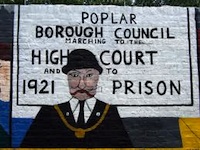 Hardie, “a latter-day Jesus”, was formed as a rebel in the Ayrshire coalfields in the 1880s and became a founder of the ILP in 1893. He was the illegitimate teenage miner, reading Carlyle and Ruskin. He cited Morris as the “greatest man whom the socialist movement has yet claimed in this country”.
Hardie, “a latter-day Jesus”, was formed as a rebel in the Ayrshire coalfields in the 1880s and became a founder of the ILP in 1893. He was the illegitimate teenage miner, reading Carlyle and Ruskin. He cited Morris as the “greatest man whom the socialist movement has yet claimed in this country”.
MacDonald, who joined the ILP in 1894 when essentially a utopian pacifist, maintained a unique popular appeal, a charisma that David Marquand explains as “partly because he spoke to and for this strand of British socialism, that produced the ILP arts guild of the middle twenties and which looked back to Walter Crane and William Morris”. Macdonald was able to “capture the imagination of the Labour movement in a way that a narrowly political leader would have found it hard to do”.
And Lansbury, who wrote from his south London prison cell about Morris, that “in the columns of Commonweal, in pamphlets, lectures and speeches, [he] made me realise that there was something more to be thought of than Acts of Parliament and state bureaucracy… Surely what we strive for is a society of free men and women bound together by ties of comradeship and communal wellbeing as pictured by Morris.”
Yet gradually, through the 1930s, the page turned. The planners, scientists, organisers and economists – Dalton, Morrison, Bevin, Jay, Gaitskill, Wilson – won out. The rationalists won out, backed by the unions who retreated into the party structures. The mechanistic, centralising remedies won out.
Webb’s mistake, according to Morris, was to “overestimate the importance of the mechanism of a system of society apart from the end towards which it may be used”. The question of human virtue becomes, at best, residual.
The romantics lost. Sure, from time to time a few creep through, such as Bevan with his focus on the aesthetic of council house production, his “emotional concern for human life”. Deeply artistic, he held a libertarian belief in the capacity of all human beings to flourish. He could make socialism sing; he was a “sensual puritan”, as described by Michael Foot.
Indeed, Foot himself had elements of the tradition, alongside Kinnock and early Blair. Yet generally this tradition has crashed, burned or been exiled.
It is Morris who lies behind the romance of socialism – its possibilities, its hopes. The sense of a creative life we could all live: that is our shared humanity. It also talks of what we have lost as we commodify our lives and our relationships; our children, our culture.
WB Yeats, wrote this of Morris: “No man I have ever known was so well loved… People loved him as children are loved. I soon discovered his spontaneity and joy and made him my chief of men.”
This devotion echoes the east end children’s devotion to Lansbury as they sang about him in the school yard.
Death and socialism
Almost exactly 80 years ago, in early December 1933, in Gainsborough, having opened a bazaar and before addressing a party meeting, Labour leader Lansbury fell and very badly fractured his thigh.
He felt close to death. He was to remain in the Manor House Hospital in Hampstead for more than six months and had his 75th birthday there.
He used the period to good effect, publishing two books within a year. The first was a second volume of memoirs, the other a volume entitled My England. This was, in effect, a new Christian socialist manifesto built around a series of articles published in the Clarion.
It is here that Lansbury declares his essential creed, his “desire always is to chain down misery and set happiness free”. The task at hand, he said, was literally “to reconstruct the whole life of the nation”.
The significance of Lansbury is best understood in these pages, especially chapter 17 entitled ‘The Joy of Living’. It is a unique blend of ILP radicalism, Christian socialism and the possibilities of human creativity and advancement inspired by Morris.
More than any other Labour politician, Lansbury had become anchored within, and spoke to, this specific romantic English radical socialist tradition. There are five essential elements:
- first, a ‘national popular’ patriotic socialism
- second, a transformative agenda that rejects a shallow-end transactional Labour politics
- third, a socialism hinged on gaining power to give it away, a trust in people and a radical democratic bent
- fourth, a feminism driven by a specific understanding of human equality
- fifth, an ethic anchored within a conception of the human condition and its creative possibilities, duties and obligations, and a sense of fellowship.
It is of direct relevance today. The book was published five years after the crash and economic rupture of 1929. It was written three years after the collapse of the second Labour government.
Today we stand in precisely the same spot in the political cycle, driven by crisis and political rupture. Today we consider Lansbury’s life five years after the epochal events of 2008 and three years after the collapse of the last Labour government, a defeat which arguably triggered our greatest crisis since 1931.
Labour has a terrible record at such historic turning points. From our inception we have been plagued by a fundamental tension between orthodoxy and radicalism, between transaction and transformation, which is especially acute at moments of crisis.
You can detect it throughout our history. Soon after its formation, Hardie argued that Labour had “its conscience dulled by lust of power to that sense of justice which is the salt of national life, it reels towards its doom.”
Twenty-five years later, in The Choice before the Labour Party, Tawney described after Labour’s retreat into national government, how the government “did not fall with a crash, in a tornado from the blue. But crawled slowly to its doom.”
It was consumed by a “cautious conventionality” which “retard[s] the recovery of the party by concealing its malady”. It courted the voters “with hopes of cheaply won benefits, and if it did not despise them, sometimes addressed them as though it did. It demanded too little and offered too much.”
His words echo down from the past, through Bevan, Kinnock and indeed Blair when railing against party orthodoxy. “The gravest weakness of British Labour is… its lack of creed,” said Tawney. “The Labour Party is hesitant in action because divided in mind. It does not achieve what it could, because it does not know what it wants.”
There is, he said, a “void in the mind of the Labour Party” which leads us into “intellectual timidity, conservatism, conventionality, which keeps policy trailing tardily in the rear of realities”.
Lansbury shared these criticisms and re-established the creed demanded by Tawney, hinged around ‘The Joy of Living’, a utopian ILP socialism to build the ‘New Jerusalem’, anchored in the streets of Bow, where you found the good Samaritan in “every court and alley”, and the desire for human self-realisation, the desire to live a good life.
The Labour Party is the vehicle to provide this “wisdom, knowledge and understanding”. It is a patriotic endeavour Lansbury equates with Irish Home Rule. He urges the party to be “born again”. It is an explicit attempt to re-establish a political sentiment after the loss and desertion of 1931, and it’s reflected in the character of his own leadership.
John Shepherd argues that a total renewal of Lansbury’s religious faith occurred in hospital. Lansbury believed he had been spared by God to carry on with his work. It was reflected in his strengthened pacifism as the drumbeat to war grew louder. There was an inevitable confrontation with the likes of Dalton, Bevin and Citrine as Labour re-examined its foreign policy with renewed emphasis on military force in the fight against fascism.
Alongside his reasserted faith, however, there is also a sense of loneliness and melancholia – his personal separation in a hospital bed; and the political isolation from a party shifting toward a more muscular patriotic identity. These are played out alongside personal tragedy. Bessie had died in 1933; his son Edgar died on 28 May 1935.
Labour today
Labour has too often renounced the transformative in favour of the transactional. It has too often retreated from the compromises and messy realities of people into the order and security of the state.
![]() Transactional politics delivers real benefits to people. But they don’t change anything fundamental in the economic structures and social hierarchies that are the dynamo of inequality. On their own they don’t generate power and self-confidence in people.
Transactional politics delivers real benefits to people. But they don’t change anything fundamental in the economic structures and social hierarchies that are the dynamo of inequality. On their own they don’t generate power and self-confidence in people.
For that sense of personal fulfilment, self-knowledge, achievement, dignity, self-esteem, of a life lived well and true to one’s self – for that you need something more, you need a story that speaks to people’s hopes and dreams and in which they recognise themselves.
A transformative politics is about voicing what people already know and feel but struggle to find the words for.
Transactional politics is about slicing and dicing the electorate in search of victory, where people are reduced to votes and units of calculus. But to what end and for what purpose?
We need the statisticians, empiricists, calculators, tacticians and policy technicians to help build a better decent society. But too often Labour has sent them forth without reason or purpose, other than a tribal urge for victory.
Too many of our manifestos end up as lists of policies, an offer to this group, a promise to that, the different parts never adding up to anything that makes sense to people. As Tawney said in 1934: ‘It demanded too little and offered too much.”
It is the One Nation frame that can hold both the transformative and transactional. Neither can win without the other.
The policy review I am involved with is about producing evidence-based policy, but it’s embedded in a deeper story of One Nation.
The story determines the policy making and the policy making gives substance and detail to the story, and both are given political reality by the movement building of our party reforms.
The mass political party of the 20th century, which George Lansbury led, is gone. The cultures and social formations of the industrial working class that gave it life and sustained it, have gone.
More recently, social democracy has suffered a cultural devastation – almost, if you like, a social death. And while the structures of our party survive, the meanings that gave them life, have not.
We are dwindling, and we have to change. We have to return to our exiled traditions and galvanise for the future.
The One Nation tradition grows out of the moral outrage at the mechanisation of society. It begins with Carlyle’s the condition of England question, in his essay on Chartism in 1839. His raging against the inhumanity of industrialisation gives first voice to the One Nation tradition: “The condition of the great body of people in a country is the condition of the country itself.”
Out of it grows the social novels of Gaskell, Dickens, Disraeli’s Sybil or Two Nations, and Ruskin. It is the tradition of an English modernity of virtue and sensibility, and Morris was its greatest exponent.
It was given form within the ILP and Labour through Hardie, MacDonald and Lansbury. It lay deep within Attlee and the texture of his great transformative government. It is captured in the character of Lansbury more than any other and saved the party at its moment of acute crisis.
Politics is always first and foremost poetic because if it lacks the spirit to transform people and give them hope for a better life then it will fail to tackle the fundamental power relations that keep them in their place, however many policies it has lined up.
That’s why, for me, Lansbury is so important, not just for what he stood for but for his failures and the lessons we can learn from his exemplary life.
Conclusions
Attlee said of Lansbury: “He was a great Londoner and a great Englishman and a socialist who practiced and preached the brotherhood of man. He was a sincere and devoted Christian who strove to follow in the footsteps of his master.”
Laski said of him, “He was absolutely straightforward, absolutely democratic and entirely fearless.”
Bob Holman described his own journey to Lansbury as reaffirming his belief in Labour for “putting socialist principles into practice in our everyday behaviour and relationships”.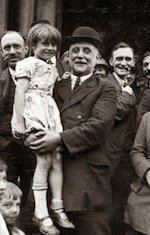
Lansbury was the quintessential Labour moralist, the utopian visionary driven by the search for co-operation and fellowship, not in the abstract but lived every day in these streets which he never left. He embodies the history of both ethical socialism and the ILP in this country.
Lansbury was a genuine radical in terms of women’s emancipation and the widening of the franchise. He was driven by fundamental concerns about human dignity and equal worth which at different times left him in Brixton and Pentonville, and on hunger strike.
Personal advancement in the House of Commons didn’t interest him. Resignation spoke volumes about his personal frustration with the Westminster party and parliament itself. Aged 53 he threw away his seat.
He was sent to Pentonville in 1913 following militant rhetoric some saw as sedition. Demonstrations and mass singing followed in support of his hunger strike. The people got him out of there.
He was the driver behind the most important public document of the last century – the Minority Report on the Future of the Poor Laws.
As Poor Law Guardian his hatred of the workhouse was personal, deep and profound. The Minority Report was the cornerstone of the future welfare state, delivered by that other great ILP east end activist, Clem Attlee. Both refused to accept the notion of the undeserving poor. We should remember that.
The 1946 legislation, with the end of the Poor Law, stands as testament to Lansbury and Attlee and east London’s humanity, captured in the ILP.
One Nation politics is about reviving the exiled tradition embodied in the life and work of Lansbury. It was built in these streets. You can literally see it in the face of the man. Dig out the old photos – his humanity glows, almost as a physical force, and the people knew it.
Memory is itself a political act, to recapture what we have lost. Lansbury saved the Labour Party because he encapsulated the soul of the party; its purpose, he said, “to chain down misery and set happiness free”.
—-
This lecture was delivered by Jon Cruddas MP at Queen Mary University London on Thursday 7 November 2013. It was the inaugural George Lansbury Memorial Lecture, an annual series organised by the George Lansbury Memorial Committee.
The George Lansbury Memorial Committee was formed in 2011 “to celebrate Lansbury’s life, work and legacy, encourage awareness of his contribution to local and national life, and promote contemporary reflection upon the various causes Lansbury made his own”.
Jon Cruddas is the Labour MP for Dagenham and Rainham and leads the party’s policy review process. More information here.
Two local pamphlets about George Lansbury are available from Bow Church which 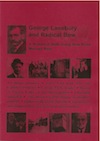 Lansbury attended: George Lansbury and the Bow and Bromley Bye-Election of 1912, by John Shepherd, and George Lansbury and Radical Bow, by Michael Peet. Both are published by Bow Press and are available for £2 from The Rector, Bow Church, 28 Coburn Street, London E3 2AB.
Lansbury attended: George Lansbury and the Bow and Bromley Bye-Election of 1912, by John Shepherd, and George Lansbury and Radical Bow, by Michael Peet. Both are published by Bow Press and are available for £2 from The Rector, Bow Church, 28 Coburn Street, London E3 2AB.
See also: ‘Good old George’, published here in December 2012, and ‘Attlee, the ILP and the Romantic Tradition’, from 2011, both by Jon Cruddas.

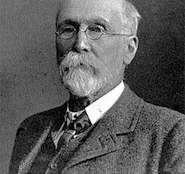
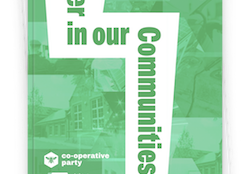
6 February 2018
My father (born May 1927) was taken by his Grandfather to see George Lansbury talk in support of the suffragettes. I think he saw him more than once but he particularly remembers seeing him with his leg in plaster so must have been early in 1934. It would have been in London, probably south. Any idea what event this could have been?
20 November 2013
The article by Jon Cruddas on ILP and Labour Party history, and the link with Ed Miliband’s One Nation Labour philosophy, is interesting and revealing. Three statements struck me as important and helpful for those, like me, who are struggling to understand what it means in policy terms, and whether or not it is realistic to expect (or even hope) for a future Labour government to turn its back on neoliberalism and the Blair/Brown past, towards an egalitarian and predistribution economy.
On Attlee, Lansbury and the ILP, he said:
“The east end of London is fundamental to the history of Labour. Two key figures, though not from here originally, had their characters forged in these streets and the local ILP of the first decade of the last century.”
On the One Nation project, he said:
“Labour has too often renounced the transformative in favour of the transactional. It has too often retreated from the compromises and messy realities of people into the order and security of the state.”
“It is the One Nation frame that can hold both the transformative and transactional. Neither can win without the other.”
“The policy review I am involved with is about producing evidence-based policy, but it’s embedded in a deeper story of One Nation.”
The quote under the Attlee paragraph is important (I think) because it seems to show that (unlike the present homogeneous look-a-like intake of MPs and would be parliamentarians) the people who helped to design and implement the post-war predistribution economy and welfare state were much nearer to the people. By-and-large they entered into politics out of conviction and anger over gross inequality and social injustice. To use an analogy, Attlee, Lansbury, et al seem a lot nearer to those running the People’s Assembly campaign, than to present day Labour politicians.
This contrasts starkly with many of those queuing up to become Labour MPs – those such as Euan Blair, Will Straw, David Prescott – whose primary motivation (not all, of course) for entering politics seems to be career progression and the attraction of power politics, whose economic, social and political preferences are likely to be pragmatic and transactional. In other words, they seem likely to do whatever they feel is necessary to work within the free market system, and maintain the centre ground and status quo without rocking the boat and enraging the forces of big money and capital.
Let’s face it, getting into cabinet and government and managing the country is the end game for many Labour MPs, and would be MPs, the sons and daughters of past Labour leaders about to be parachuted into safe Labour constituencies.
But Cruddas’s transformative concept is something entirely different and, on the face of it, seems to be a genuine attempt to get the Labour Party to change direction in the most difficult and complex circumstances.
This kind of thinking is on a completely different level from his ‘Conditions of Britain’ speech at the IPPR, when he did talk at length about the need for a new social compact, for social justice, and outlined a very attractive list of what a good society might look like. He also gave unequivocal support for a living wage and is one of the few Labour politicians who said emphatically that the Blair and Brown versions of neoliberalism were mistakes, and that we need a new system of bottom-up politics.
In retrospect some of his critics at the ILP weekend school (including me) should have been a bit more generous in acknowledging this, and maybe a tad less quick to rubbish the totality of what he had to say. But years of political spin, duplicity, frustration and disillusionment does take its toll.
However, Cruddas did mix this relatively good-news message with some unimpressive and lightweight comments, saying things like:
“Across the country we are re-building a campaigning movement for change.”
“And in local government we are testing ideas to build economic growth and social resilience.”
“To me all roads lead back to Dagenham Boxing Club.”
It was this sort of talk that, for me, devalued his message. To my mind, it is just a pity that we did not have an article like his Lansbury memorial lecture, and comments on the predistribution economic model, to use as set reading in preparation for the ILP discussion at Scarborough.
19 November 2013
It is a fine lecture and as it centres upon Lansbury, we can only expect some general indicators when Jon turns to the way forward for his ‘Labour Today’. But for modern politics, I can’t help feeling that we are just being asked to put our faith in Jon. As he is co-ordinator of Labour’s policy review, we can only wait to see what he will help it to bring forth.
Perhaps Labour will go into the next election pushing for a form of (socialist?) transformative politics. Yet the evidence for this is thin. Even if the Labour Party has shrunk as an internal structure, why can’t its members and affiliated bodies be given a say in shaping the way forward?
Admittedly, if we are computer experts and wonks, we can individually shoot off our ideas to all the Labour Party policy reviews and to somethings called ‘Task Forces’ – although, we don’t even need to be members of the Labour Party to do much of this. Experts in these mysteries can even get branches, constituencies and all-member meetings to send in their ideas. If we devout our efforts to such work then, as individuals and groups, we may even get listed at the end of a policy review report. But we won’t find out what each of us has been pressing, unless (indirectly) those who produce the policy reviews happen to agree with us.
We can’t even get access to official NEC minutes. But thankfully Ann Black (and others) spill the beans via unofficial reports. So we know the following about the meeting on 4/5 November: “Angela Eagle and Jon Cruddas outlined the next stages of policy development. Key Dates are:
FEBRUARY 2014: the final consultative documents published on the Your Britain website.
FEBRUARY-JUNE 2014: amendments and submissions accepted by Jon Cruddas’s policy reviews and shadow cabinet, and external reviews will be fed through the policy commissions – these may amount to 60 separate pieces of work, unless I’m double-counting.
JUNE 2014: NPF representatives meet in regional groups to decide which amendments to take forward.
18-20 JULY 2014: national policy forum meets to finalise documents.
OCTOBER 2014 – MARCH 2015: manifesto development based on policy programme.
SPRING 2015: Clause V meeting agrees manifesto.
This means that the consulations run alongside campaigning through to 22 May 2014, but perhaps local parties can organise policy discussions followed by door-knocking sessions.”
Perhaps these matters should form a close focus for study by the ILP in the coming 18 months or so. It would be a useful aid for wonks. It would also give us food for thought when most of our ideas bite the dust. Or am I underestimating Jon’s influence and Ed’s hidden agenda?
I am currently pursuing an interest in local government, a structure which has been virtually destroyed since the 1970s. What form of transformative politics does it require? We have until 14 December to submit ideas to Labour’s Local Government Task Force. Perhaps Jon could tell us how such bodies are established, how they fit into the policy review procedure, and how are they financed? Even Ann Black finds it all to be a mystery.